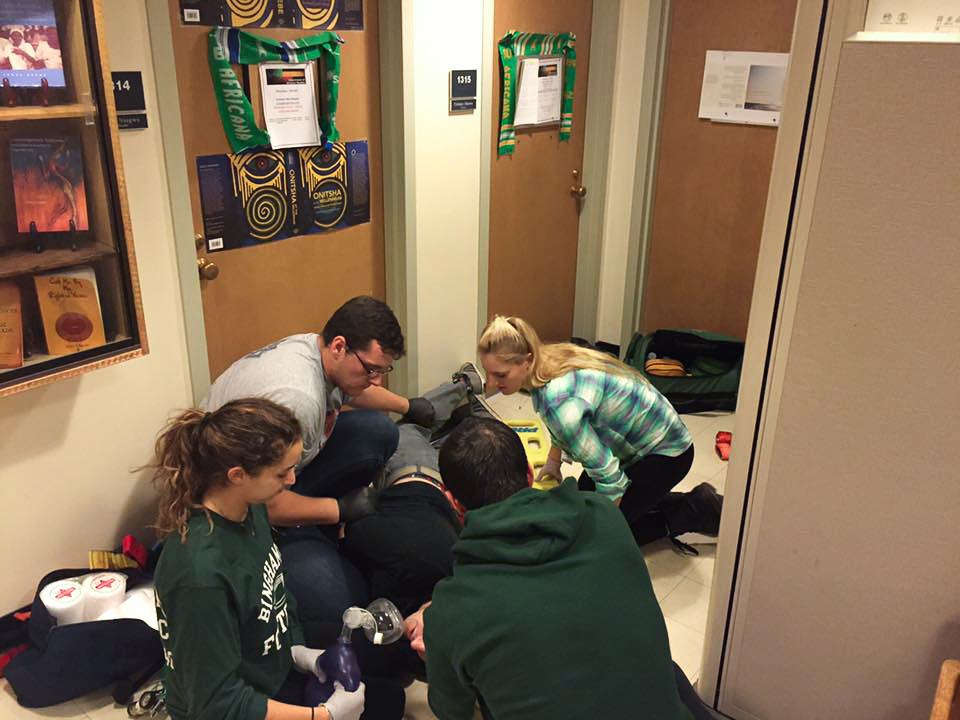
“I got addicted.”
Stephen Baumgarten, the first assistant chief and deputy director for the agency and a first-year graduate student studying public affairs, isn’t talking about drugs — he’s talking about working for Harpur’s Ferry, Binghamton University’s student-run ambulance service.
Baumgarten works closely with Chief and Executive Director Meir Berkman, a senior majoring in philosophy, politics and law, to supervise the student responders. According to Berkman, the agency responds to a range of calls related to drugs and alcohol, and sometimes, what seems to be some other kind of call will end up involving drugs too.
“[Our call volume] ranges anywhere from people who are just kind of awake and oriented and kind of concerned about the fact that they drank too much to people who are unconscious and barely breathing, sometimes, who drank too much,” Berkman said. “Within those calls, oftentimes or sometimes, we’ll find out during the course of treatment that there were other drugs involved.”
Berkman estimates that around 20 percent of the calls that Harpur’s Ferry responds to involve drugs or alcohol, though it can be hard to pin down an exact figure for a few reasons. Patients don’t always tell responders what drugs they have used, either because they are afraid of negative repercussions or because they are unresponsive. In addition, responders generally only record the symptoms that patients exhibit, rather than a specific drug that was taken.
“Regardless of what type of drug somebody has abused, if they’re in trouble and they’re displaying some sort of a symptom, we treat that symptom, and so if they’re having difficulty breathing, we treat the difficulty breathing,” Berkman said. “If they’re unconscious, we try to figure out and deal with the fact they’re unconscious by treating that in a specific way. There are a few times where we treat specific drugs specific ways, so Narcan [for opiates] is a good example of that.”
Baumgarten added that responders generally treat symptoms associated with two kind of drugs: depressants and stimulants.
“Depressants slow your body down, stimulants speed them up, and so extremes of those can cause a lot of problems, so we kind of teach our providers to look at those two things, and determine which path it’s going down and kind of how to correct that,” Baumgarten said.
Because Harpur’s Ferry is part of the Broome County Emergency Medical Services Mutual Aid Plan, they can be called upon to respond throughout the county when other agencies are unable to. This puts them into contact with more than just the student population, and though Berkman said that opiate calls are uncommon on campus, Harpur’s Ferry responders are trained to use Narcan to respond to heroin overdoses and similar calls, which are more common in places like the city of Binghamton.
The types of drugs Harpur’s Ferry responds to changes during the course of the semester. Alcohol calls, for example, are more common at the beginning of the semester, when course loads are lighter. The agency receives more calls relating to study drugs and caffeine during midterms and finals.
“When it comes to finals week or midterms, we will oftentimes treat people who’ve now had their eighth Red Bull and sixth cup of coffee over a two-hour period, and now they’re complaining that their heart’s racing, and they’re not wrong, it probably is racing, and those are dangerous things too,” Berkman said. “We’ll [also] see Adderall, and we’ll see Xanax and medications that you would think are consistent with things people would take to either calm themselves down or help them focus more.”
This trend of self-medicating with study drugs is consistent with patterns across the county. The Center on Young Adult Health and Development at the University of Maryland found that 31 percent of college students have used such drugs for nonmedical reasons, and Baumgarten said that Harpur’s Ferry responders see many calls in which these drugs are related to academic pressure.
“[We] see those study drugs are really — a lot of the times — tied with mental health and people being really, really stressed out around finals time, and taking those drugs and not taking care of their mental health,” he said. “That’s another kind of trend we see.”
Berkman and Baumgarten stressed that their responders are instructed to get as much information from the patient without incriminating them, and that even though police often accompany their ambulances on a call, it is more to ensure the safety of responders, patients and bystanders than anything else. Anyone who calls Harpur’s Ferry is protected by New York state’s 911 Good Samaritan Law, which promotes the safety of all parties over the prosecution of anyone for drug possession or underage use of alcohol.
“We treat the patient and we don’t judge the patient,” Berkman said. “We’re very serious about that.”


